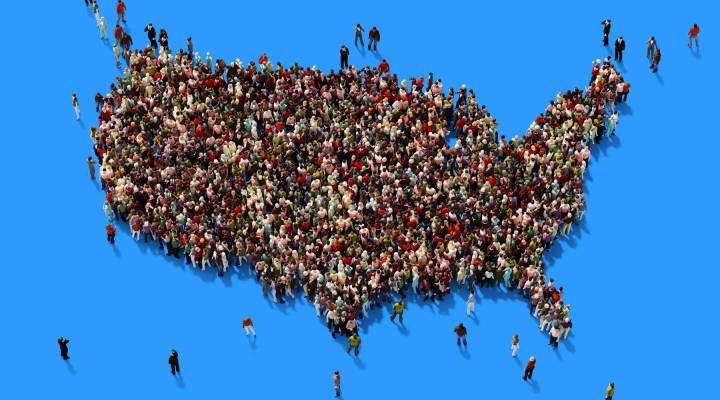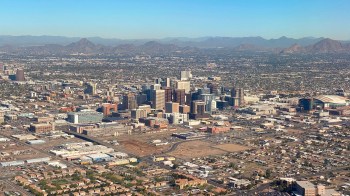
The fastest—and slowest—growing counties in the U.S.
Share Now on:
The fastest—and slowest—growing counties in the U.S.

Immigration is a major factor driving population growth across America. Areas like Harris County, Texas, and King County, Washington, have experienced some of the largest increases in international migrants, according to new data from the U.S. Census Bureau.
“With less population growth from what’s called ‘natural increase’ — births minus deaths — a larger share of U.S. population growth is coming from international migration,” said Jed Kolko, chief economist at Indeed.com.
Kolko said that nationally, population growth is slowing because birth rates are down and death rates are rising. And slow population growth can be compounded by low rates of migration (domestic or international) — you’ll see that in parts of the country like Wyoming County, West Virginia.
We took a closer look at some key highlights from the U.S. Census Bureau’s latest data release.

The areas that make the most populous list in the U.S. have remained largely unchanged over the years, with counties containing diverse, metropolitan cities. Los Angeles County, California, has the largest number population, with more than 10 million people, while other Californian counties, like San Diego County and Riverside County, also reported large populations. Cook County, Illinois (home to Chicago) made second on the list with 5.2 million, followed by Harris County, Texas, and Maricopa County, Arizona.
While these counties have the highest overall numbers, here’s how things break down when you look at the rate of population increase.

Indeed.com’s Jed Kolko said that North Dakota — making the top of this list — has drawn in people because of its oil boom, which has created lots of jobs in the oil industry. Kolko said that the parts of North Dakota that have particularly seen a lot of growth have access to the Bakken Formation, a rock unit that serves as a large source for oil. Williams County, with a population growth rate of 5.9%, is one of them.
However, the oil boom has led to both population booms and busts in some of the towns in the state. In terms of sheer numbers, Texas counties dominated the list, with four landing in the top 10. Lloyd Potter, Texas’ state demographer, told Marketplace’s Andy Uhler that its strong economy and relatively low cost of living help drive people into the state.
“If you were in California, you could come to Texas, take a job, take a cut in pay, get a bigger house, drive a new car and you would still be saving more money than you were when you were living in California,” he said. International migration is also fueling growth in Houston and Dallas, while domestic migration is helping growth in Austin and San Antonio.
Another state whose counties made the top 10 is Florida. Kolko said that parts of Florida have attracted older adults and retirees, which in turns creates jobs for others in industries like health care, real estate and tourism. (However, some areas in Florida, like Miami, will more likely experience population growth through factors like international, rather than domestic, migration.)

Aransas County, Texas, was the slowest growing region in the U.S. (based on areas with at least 20,000 people). Lloyd Potter pointed to Hurricane Harvey — a cyclone that devastated many areas in Texas — as one of the reasons for that. Rockport, a city in Aransas, County, was in Harvey’s direct path. Mayor Charles J. Wax described parts of the town as “completely gone, a pile of sticks,” according to the New York Times.
“The net-out domestic migration was driven by housing units being lost from Harvey,” Potter said.
Wyoming County, West Virginia, which lost about 2% of its population, ended up on the list. The state’s overall population has been on the decline, with one of the country’s highest death rates, one of the lowest birth rates, and an overall drop in net migration.
In Dallas County, Alabama, the population also fell more than 2%. The county includes the town of Selma, home to the 1960s voting rights movement, which is the fastest shrinking city in the state.

Miami-Dade County, Florida, had the biggest total net increase of international migrants, with nearly 59,000 coming into the area between July 2017 and June 2018. Other regions in the state that made the list include Broward County, with about 21,000 international migrants, and Orange County, with nearly 20,000.
Florida has had very strong ties to Latin America for a long time, Kolko said, which helps account for those numbers. However, he added that Hurricane Maria took place during this period of growth. After Maria, thousands left Puerto Rico, many of them first heading to Florida. (Note: The U.S. Census Bureau counts people who moved from Puerto Rico to the U.S. as part of its “international migration” numbers. However, Puerto Rico is part of the U.S. and its residents are U.S. citizens.)
The types of counties with high rates of international migration also include big, diverse metropolitan and college towns. Kolko said that college towns attract students and faculty from abroad, and are often surrounded by clusters of scientific and technical industries, which have a large percentage of foreign-born workers.
So it’s no surprise that Santa Clara County, California (home to Silicon Valley), and Kings County, Washington (home to Seattle, where Amazon and Microsoft are based), are in the top 10.

If you look at international migration broken down by percentage, instead of net numbers, Florida continues to dominate the list. But a couple of parts of Virginia (Alexandria and Fairfax, both independent cities) also made it on. William Frey, a senior fellow at the Brookings Institution, said both high-tech and low-tech jobs are opening up in the state.
The Washington-Arlington-Alexandria metro area in D.C. has the second greatest number of workers in science, technology, engineering and math (STEM) fields, more than 3 million, just behind the New York metro area.
There’s a lot happening in the world. Through it all, Marketplace is here for you.
You rely on Marketplace to break down the world’s events and tell you how it affects you in a fact-based, approachable way. We rely on your financial support to keep making that possible.
Your donation today powers the independent journalism that you rely on. For just $5/month, you can help sustain Marketplace so we can keep reporting on the things that matter to you.


















